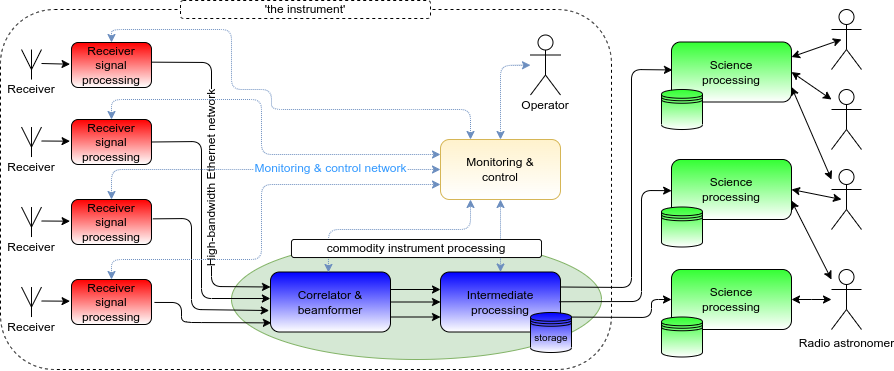Introduction
A radio telescope can be considered a streaming digital signal processing system. The sky is sampled with a receiver, and almost immediately analogue data is converted to the digital domain so we can conveniently transport it without loss and use general purpose commodity hardware to do signal processing on the result. This is shown in the schematic overview below.
Fourier transforms make up a significant portion of the signal processing steps in a radio telescope, both in spectral filters, as well as in transforming data from the uv-plane to an image suitable for science processing. Radio astronomy exists by virtue of the existence of the Fast Fourier Transform (FFT) and abundant and cheap computers to run these. Unfortunately the Fast Fourier Transform, altough very efficient, does introduce artifacts and limitations. For instance, in the imager we need to convolve the more or less randomly spaced receivers onto a regular grid, unsurprisingly called gridding, to suit the FFT. (digital) Direct Fourier Transforms do not have this limitation but are prohibitively more expensive in compute requirements.
Analogue and optical processing
Optical processing in a radio telescope frontend has been investigated in detail. In particular optical beamforming, essentially true time-delay beamforming by means of programmable optical delay lines, has been demonstrated both in macro-level setups, as well as in silicon chip form. Further investigation of this technology is currently planned at ASTRON in the NL-ECO project. This would yield an analogue optical signal path that we could leverage for further processing.
This project
In this project we will investigate whether further optical computing is viable in a radio telescope. In particular we investigate the viability of an optical Fourier Transform in the form of refraction, or potentially diffraction, of an optical signal. This could be useful in the receiver signal processing chain, as part of a spectral filter but also much further along in the processing pipeline, as part of the imaging step in the calibration and imaging pipeline (intermediate processing in the image above).
We expect that such a radical change would require a significant re-think of the entire radio telescope system. We would also need to evaluate if such a change would yield similar, or potentially better, signal quality compared to the current state of the art. Whereas a digital Fast Fourier Transform is always going to be a (very good) approximation, an analogue optical Fourier transform should be exact, depending on the quality of the optical materials. Would this impact our system quality?
Goals of this project
We are interested in answering the following questions:
- in radio astronomy the Fast Fourier transform is ubiquitous en a source of much computational overhead. Can an optical Fourier transform, based on difraction or refraction, be used to take the place of the digital Fast Fourier transform in some cases?
- what is the energy consumed by such an optical system compared to the current state of the art?
- How would one have to change the current infrastructure of a radio telescope to accomodate such an optical Fourier Transform?
- Would there be a change in accuracy and/or precision associated with this change?
What we develop
The deliverables in this project are:
- a concept design of a radio telescope with optical Fourier transform in place of a digital FFT
- an estimate of the change of energy consumed and accuracy and/or precision achieved by this novel design compared to the current state of the art
- an experimental proof of concept in the lab
